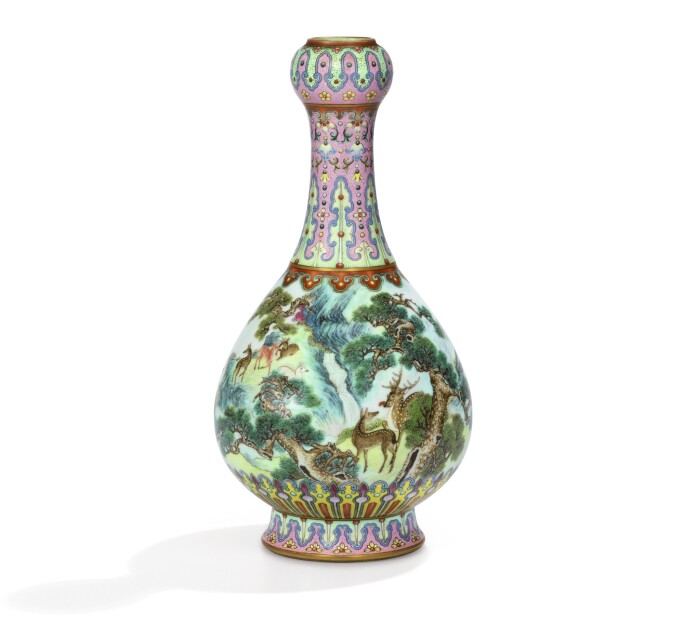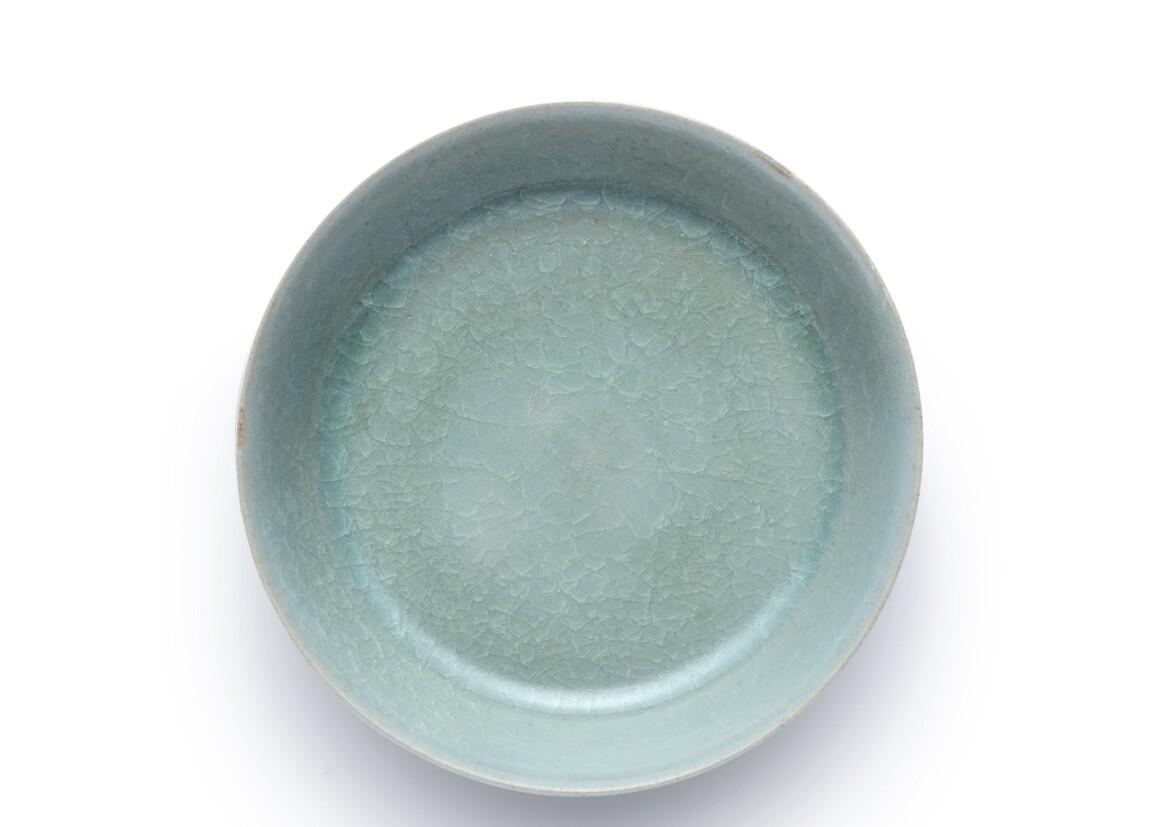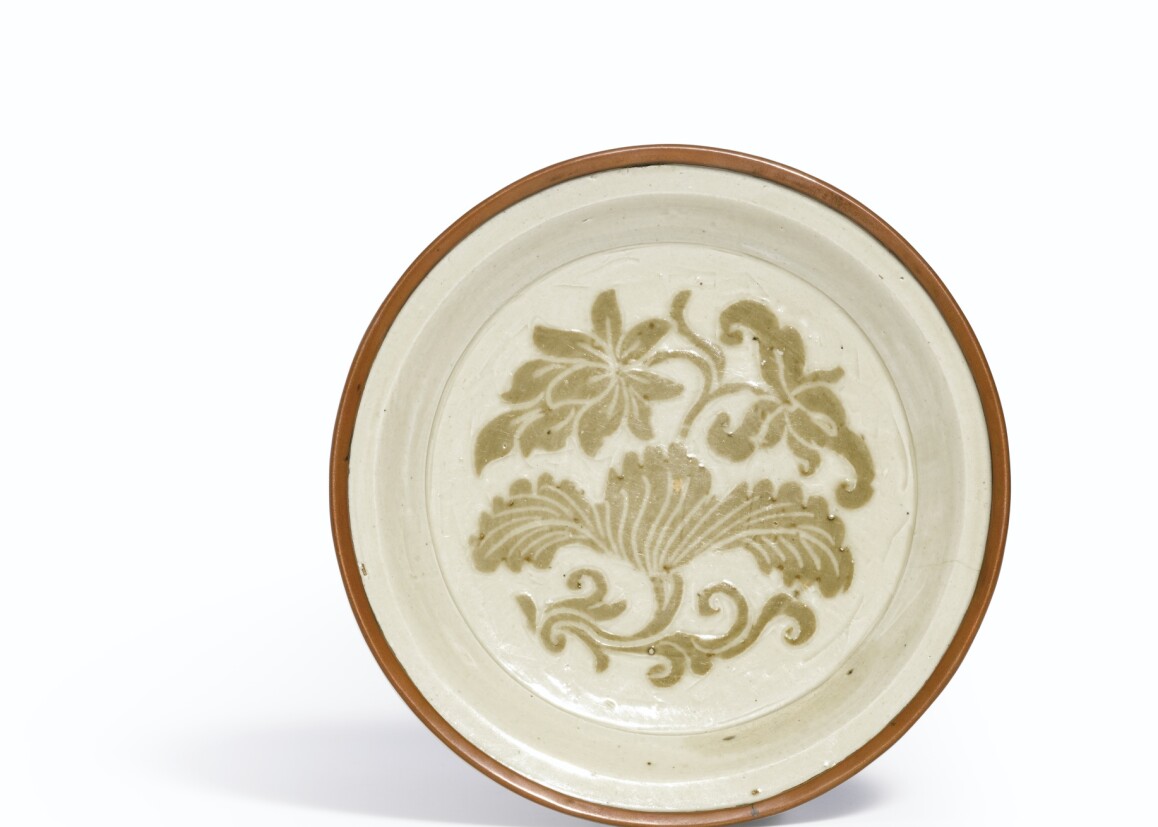Innovation in a Tumultuous Time
The four hundred years between the prosperous Han (206 BC to AD 220) and Tang dynasties (618-907) were tumultuous yet innovative. During the Jin dynasty (265-420), Yue kilns in Zhejiang province flourished to unprecedented levels to produce a variety of wares. The characteristic of these wares are their tactile greenish glazes, non-prescribed forms and unusual decoration.
 A LARGE AND RARE 'YUE' CELADON GOOSE-HANDLED JAR
A LARGE AND RARE 'YUE' CELADON GOOSE-HANDLED JAR
WESTERN JIN DYNASTY
LOT SOLD FOR HK$2,740,000
Metropolitan Splendor: Silk Road and Tang Sancai Wares
 A RARE SANCAI-GLAZED POTTERY BASIN
A RARE SANCAI-GLAZED POTTERY BASIN
TANG DYNASTY
LOT SOLD FOR US$250,000
The Tang dynasty was characterised by strong rule, economic expansion, successful foreign diplomacy as well as artistic and cultural advancements. The first half of the dynasty saw an unprecedented rise in the ingenuity and skills of the country’s artisans who strove to meet the rising demands of an affluent and discerning aristocracy. Chang’an was a true cosmopolitan at the time, and with the increased exchange with Western Asia through the Silk Road, the capital city allowed craftsmen to come into contact with an abundance of styles and techniques, which they quickly synthesized in creating the aesthetic trends of the period. Sancai wares are best known for their ostentatious decorations and opulence in variety, reflecting the inventiveness of inventiveness of the potters aimed at pushing a medium to its limits. Their vast repertoire of shapes and designs were likely inspired by metalwork, glass, textiles and any other fine materials encountered by Tang craftsmen, and absorbed motifs and design concepts that had arrived in China.
Song Ceramics: Understated Beauty
Ceramics of the Song dynasty (960-1279) are surprisingly contemporary in their understated aesthetic sense, 'Ru', 'Guan', 'Ge', ‘Jun’ and 'Ding' wares are named the ‘Five Famous Wares’ of the Song dynasty as defined by collectors of later periods. Ru Guanyao is the official ware of the late Northern Song (960-1127) court from the kilns in Ruzhou, and has achieved almost mythical status over the last 1,000 years and considered the crowning glory of any collection of Chinese works of art. However, they are and always were virtually unobtainable. Starting in 1940, no more than seven Ru vessels have ever appeared at auction; and in October 2017, a Ru Guanyao washer was sold at Sotheby’s Hong Kong for a recording breaking HK$294.3 million. Fortunately, there is a wide variety of Song ceramics at different price points, showcasing the distinct combinations of glazes, decorations and forms made in this dynasty revered for its refinement in the arts.
A HIGHLY IMPORTANT AND EXTREMELY RARE RU GUANYAO BRUSH WASHER
NORTHERN SONG DYNASTY
LOT SOLD FOR HK$294.287,500
A RARE ‘DINGYAO’ SLIP-DECORATED DISH
NORTHERN SONG DYNASTY
LOT SOLD FOR £557,000
Yuan Dynasty Blue-and-White that Travelled Afar
During the Yuan dynasty (1271-1368), blue and white porcelain developed in Jingdezhen of Jiangxi province became increasingly popular, earning Jingdezhen the recognition of China’s ceramic metropolis. The cobalt ore used in the blue pigment for Yuan dynasty blue-and-white wares were originally imported from Persia. While a formative influence in Yuan blue and white designs and shapes came from Islamic metalwork, Jingdezhen potters often offered their own interpretation of foreign aesthetic taste. The large blue-and-white porcelains of the Yuan dynasty are amongst the most impressive and characteristic product of that period. Porcelains of this type, with their bold potting and elaborate cobalt-blue decorations, were exported all over Asia and highly sought after for their durability and suitability for Middle Eastern banquets.
 A RARE AND IMPORTANT BLUE AND WHITE BARBED 'BANANA PLANT AND PEONY' CHARGER
A RARE AND IMPORTANT BLUE AND WHITE BARBED 'BANANA PLANT AND PEONY' CHARGER
YUAN DYNASTY
LOT SOLD FOR HK$29,880,000
 AN EXCEPTIONALLY IMPORTANT AND FINE DOUCAI 'CHICKEN CUP'
AN EXCEPTIONALLY IMPORTANT AND FINE DOUCAI 'CHICKEN CUP'
MARK AND PERIOD OF CHENGHUA
LOT SOLD FOR HK$281,240,000
Ming: A Distinct and Confident Repertoire
No other period in China’s history is so closely associated with ceramic production than the Ming dynasty. Its porcelains have attained such recognition that the word “Ming” has almost become a generic term for any piece of Chinese ceramic created before the 20th century. By the Ming dynasty, with the establishment of the Imperial Kilns at Jingdezhen, potters had developed a distinct and confident repertoire of designs in blue-and-white wares. In addition to this iconic type, monochrome and various polychrome styles were also produced during this period, such as the fabled ‘chicken cup’, one of such sold at Sotheby’s in 2014.
 A FINE AND MAGNIFICENT IMPERIAL 'YANGCAI CRANE-AND-DEER RUYI VASE'
A FINE AND MAGNIFICENT IMPERIAL 'YANGCAI CRANE-AND-DEER RUYI VASE'
SIX-CHARACTER IRON-RED QIANLONG SEAL MARK AND PERIOD
LOT SOLD FOR €16,182,800
Qing Dynasty: Innovating and Perfecting
The Kangxi Emperor of the Qing dynasty (1644-1912) successfully revived the Imperial porcelain factories at Jingdezhen after a long dormant period that lasted nearly sixty years. Under the reigns of Kangxi and his successors Yongzheng and Qianlong, Qing imperial porcelain workshops found inspiration from revered art objects throughout the history of china, including Ming ceramics, and combined it with ground-breaking developments in porcelain production to produce a vast quantity of high quality wares that were both innovative and classical. Among the most important contributions made to Chinese ceramics is the development of opaque overglaze enamel colours, which allowed painters to create a greatly expanded range of shades and hues.

